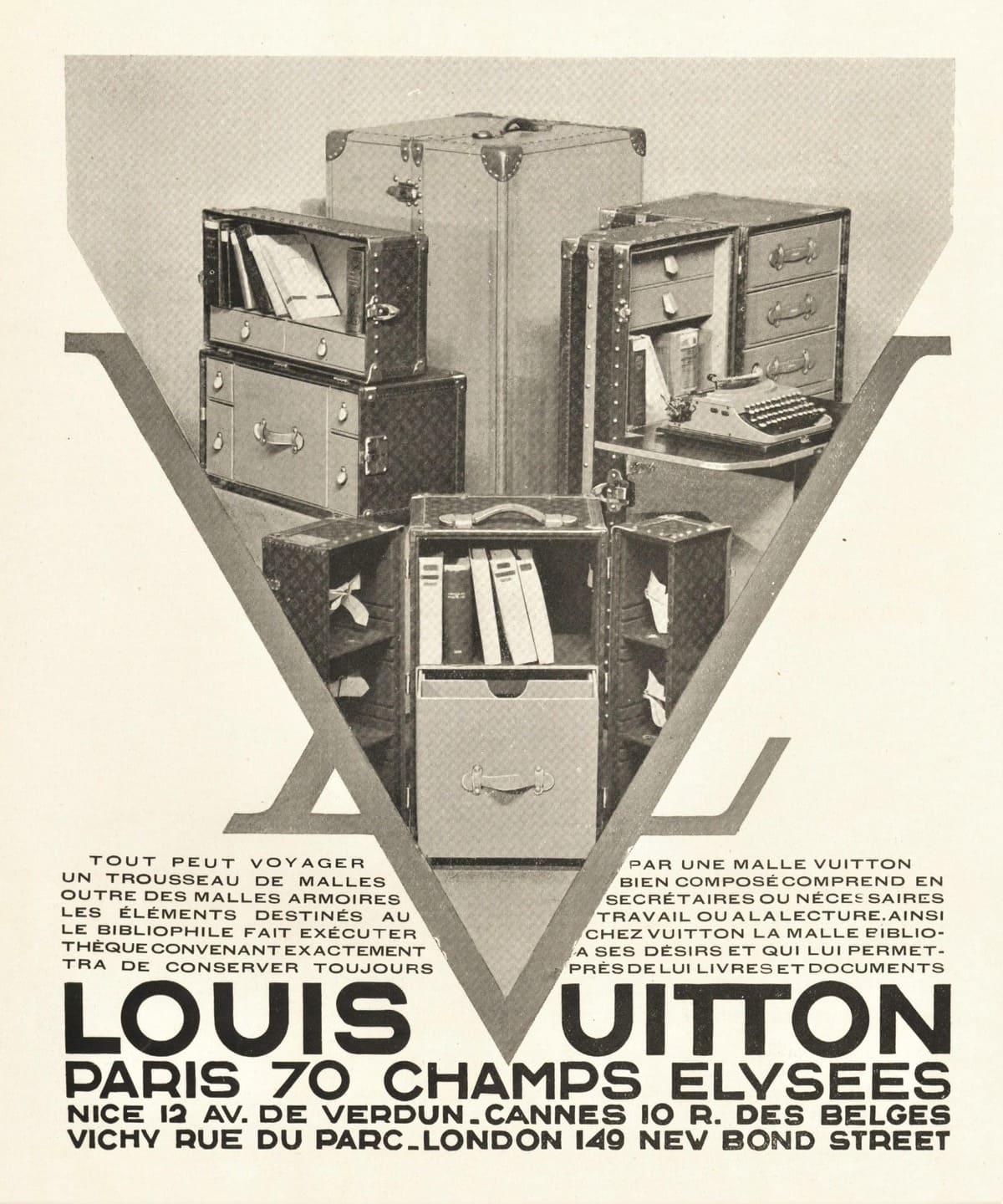Since its founding in 1854, Louis Vuitton has evolved from a pioneering luggage company to a global fashion powerhouse. Louis Vuitton himself introduced the revolutionary flat-topped trunk that made stacking and traveling easier, transforming the luxury luggage market forever. After his passing in 1892, his son Georges Vuitton took the reins, leading the brand into a new era of expansion and creativity.
Georges immortalized his father’s legacy by creating the iconic “LV” monogram in 1896, a symbol that quickly became synonymous with luxury and prestige. This distinctive mark, accompanied by signature floral motifs, has since been reimagined by artistic directors like Marc Jacobs, Nicolas Ghesquière, and Virgil Abloh, adapting it to contemporary tastes while preserving the brand’s historic DNA.
Over the years, Louis Vuitton has expanded its range to include ready-to-wear, accessories, and fine jewelry, becoming a byword for quality and sophistication. From Paris to New York and Tokyo, the brand’s influence has permeated the world’s most iconic cities.
Iconic LV “The Journey” Advert
How to tell Louis Vuitton is vintage from the logo
The Louis Vuitton logo stands as one of the most recognizable symbols in the fashion world, but its creation and evolution reflect a rich history of innovation and tribute. In 1896, Georges Vuitton crafted the iconic “LV” monogram to honor his late father, infusing it with distinctive floral motifs that symbolize fortune, joy, and passion. This signature blend of initials and emblems became synonymous with luxury and exclusivity, setting the brand apart.
Since then, creative directors like Marc Jacobs, Nicolas Ghesquière, and Virgil Abloh have continued to reinterpret and refresh the logo. Their distinctive artistic touches have infused it with kaleidoscopic colors, futuristic metallic finishes, and playful block letters, ensuring its relevance across generations and changing tastes. Each iteration reflects a blend of streetwear and travel styles, keeping the 125-year-old symbol current and coveted.
The Louis Vuitton logo has evolved since the brand’s founding in 1854, providing a visual signature that represents luxury and quality. Below is a guide detailing the brand’s logo history.
- 1854: The company is founded, and the initial logo features the full “Louis Vuitton” name with location addresses in London and Paris.
- Late 19th Century: Early logos include decorative and heraldic elements, emphasizing the brand’s prestige and legacy.
- 20th Century: The LV monogram becomes prominent, symbolizing elegance and modernity. The logo focuses more on simplicity and the recognizable LV motif.
- Current Day: The logo is streamlined with the LV monogram as the focal point, accompanied by the words “Louis Vuitton Paris.

1854 to now Louis Vuitton logo
The evolution of the Louis Vuitton logo over time reflects the brand’s adaptation to changing design trends while maintaining a core identity synonymous with luxury and exclusivity.
How to tell if Louis Vuitton is vintage from the tags
The evolution of Louis Vuitton tags is a window into the brand’s storied past, offering insight into changing trends while maintaining a core of timeless elegance. In the 1970s, tags featured distinctive location addresses like Rue Scribe in Paris and New Bond Street in London, emphasizing the brand’s prestigious origins. By the 1980s, the company began using stitched leather tags embossed with “Louis Vuitton Paris Made in France,” reflecting a focus on craftsmanship and authenticity.
Moving into the 1990s, tags incorporated fabric labels with “Louis Vuitton Paris” text and additional sizing details, a nod to the emerging global market and a wider range of ready-to-wear collections. In the 2000s, tags evolved once more, adopting a refined look with gold lettering on dark backgrounds and yellow stitching, signifying a blend of tradition and modern sophistication.
Confused by your vintage labels? Upload a picture on our vintage tag identification page, and we’ll assist you!
1970s vintage Louis Vuitton tags
- Features “Louis Vuitton Paris” with location addresses like 1 Rue Scribe and 149 New Bond St. London.
- Early Louis Vuitton logos and badges have distinctive decorative elements and often display medals or awards.
- The design focuses on historical and prestigious branding.
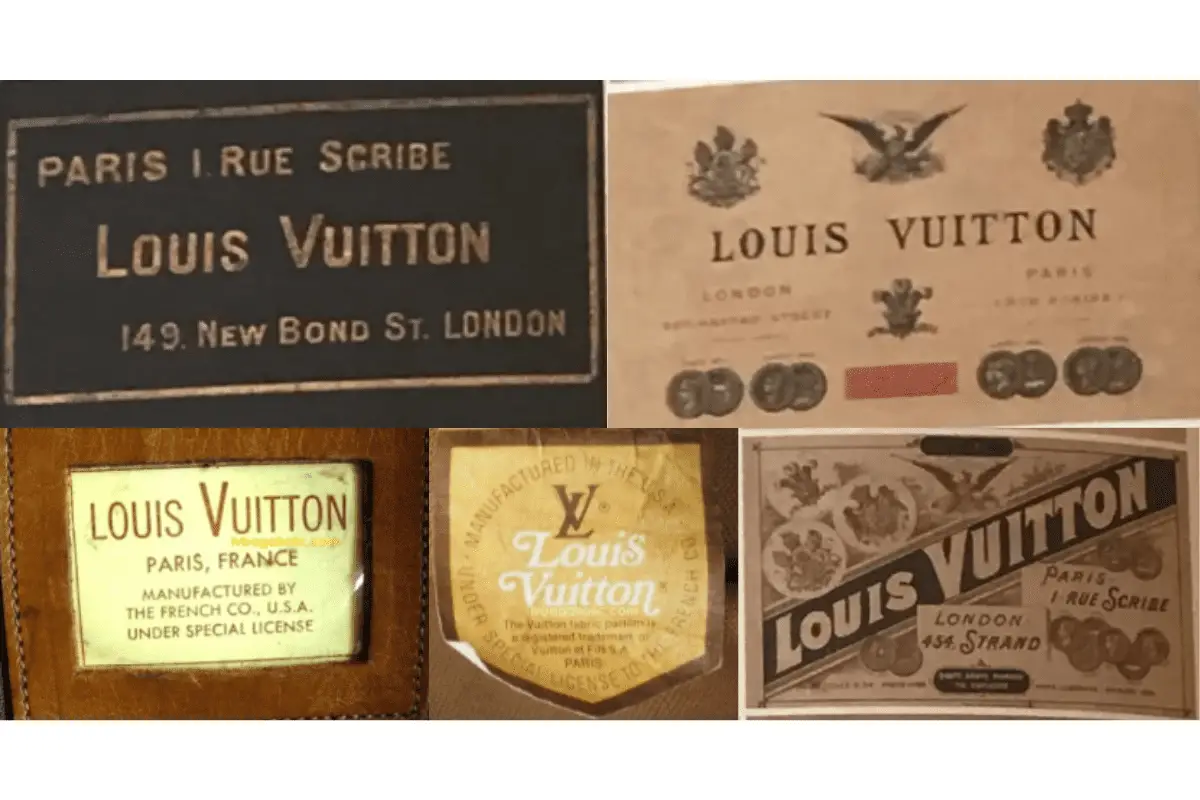
1970s Louis Vuitton tags
1980s vintage Louis Vuitton tags
- Stitched-on leather tags with embossed “Louis Vuitton Paris Made in France” text.
- Some tags include “Manufactured in the USA under special license” for American-made products.
- Wool tags show fiber compositions, cleaning instructions, and origin information.
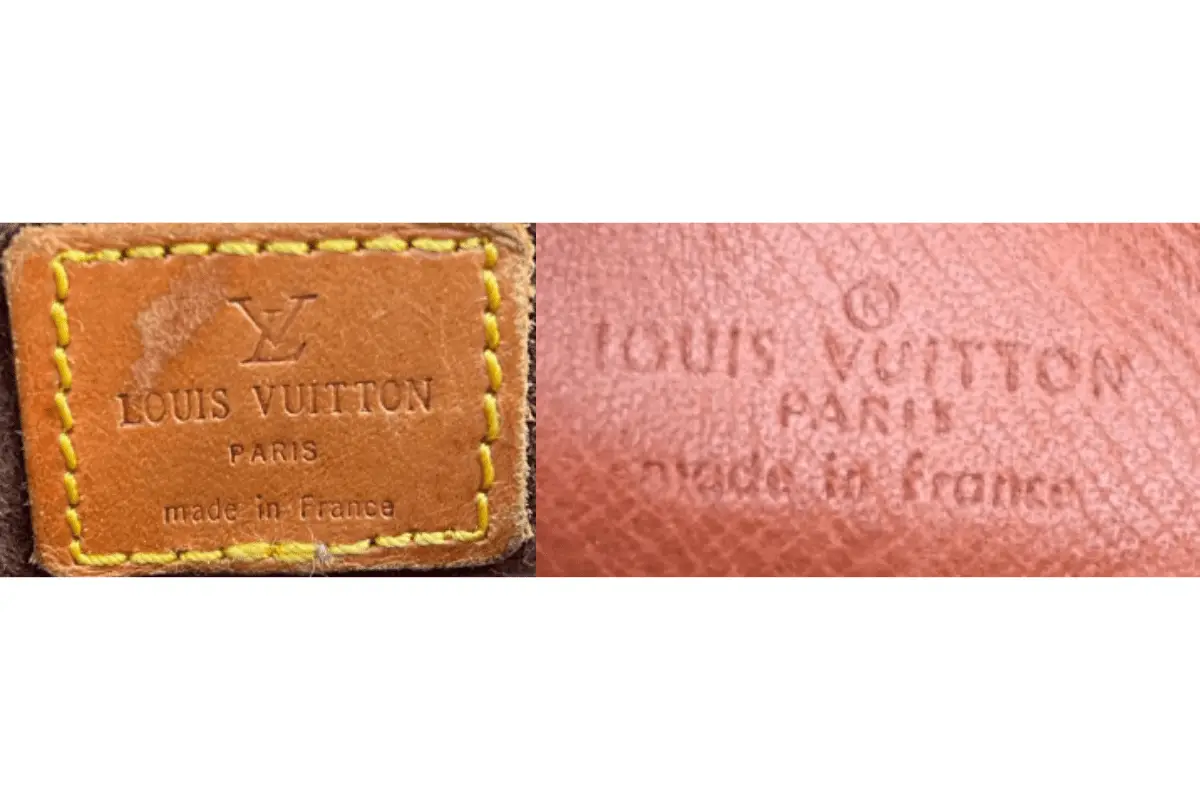
1980s Louis Vuitton tags
1990s vintage Louis Vuitton tags
- Embroidered logos on fabric tags with “Louis Vuitton Paris” text and additional sizing tags.
- Leather tags often feature the “LV” logo along with “Made in France” or “Made in Italy.”
- Composition tags on clothing provide fiber details and care instructions.

1990s Louis Vuitton tags
2000s vintage Louis Vuitton tags
- Tags feature “Louis Vuitton Paris” in a golden font on a dark fabric background.
- Leather tags include yellow stitching with “Made in France” or “Made in Italy” text.
- Care tags provide cleaning instructions, fiber composition, and country of manufacture.
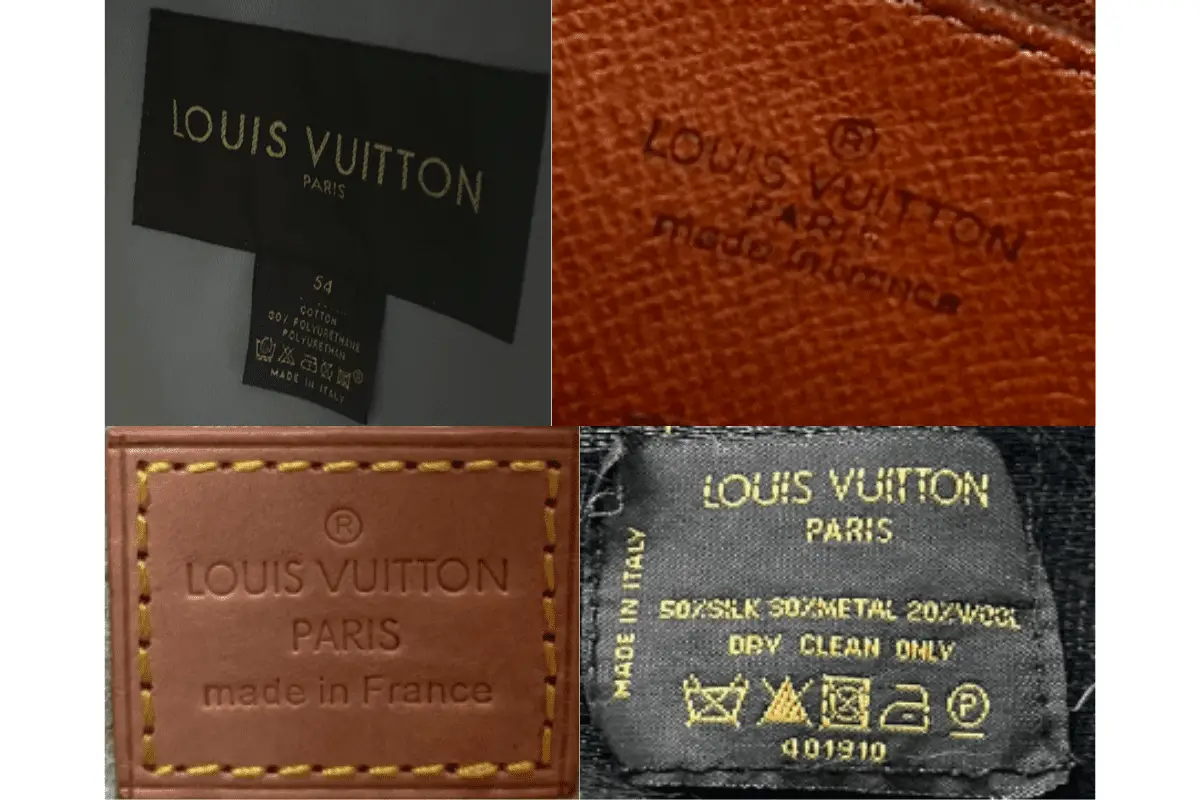
2000s Louis Vuitton tags
2010s vintage Louis Vuitton tags
- Tags are consistent with the 2000s era but often include an “®” registered trademark symbol.
- Leather tags are embossed with “Louis Vuitton Paris” and the “®” mark, along with country of origin.
- Fabric tags feature “Louis Vuitton Paris” text with bold gold letters on dark backgrounds.
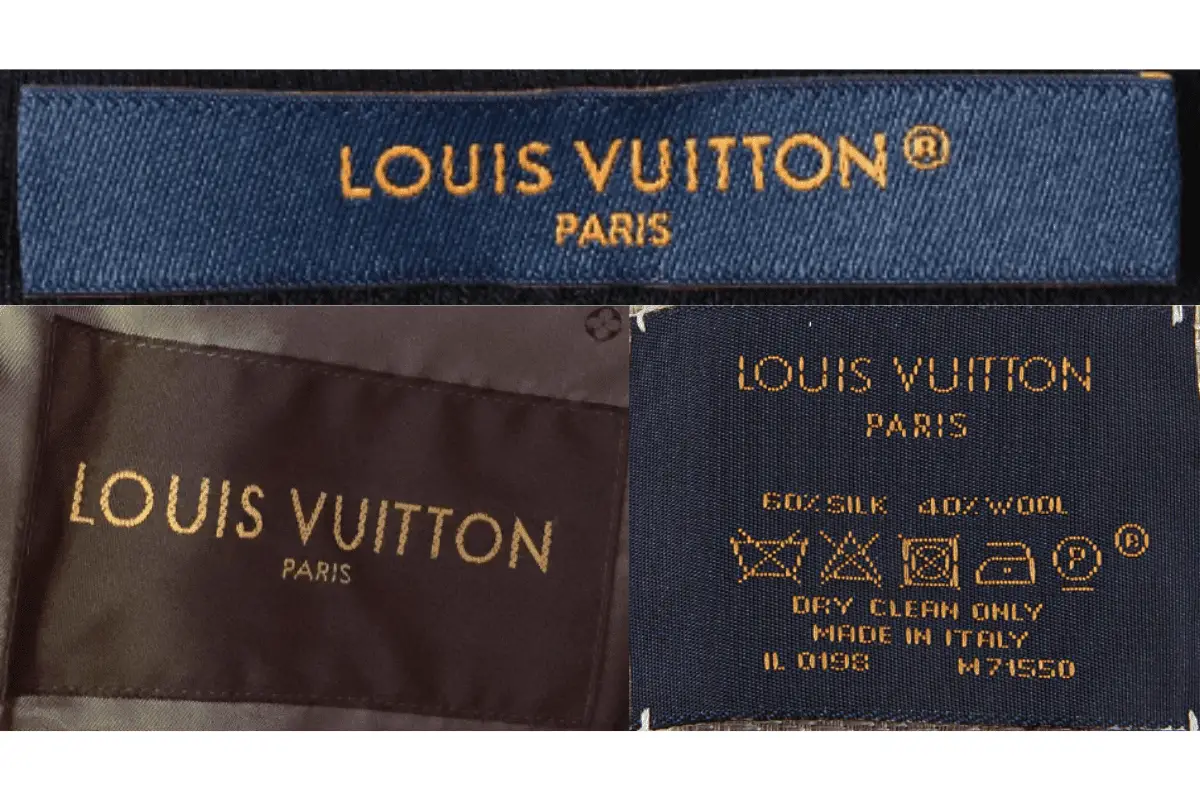
2010s Louis Vuitton tags
